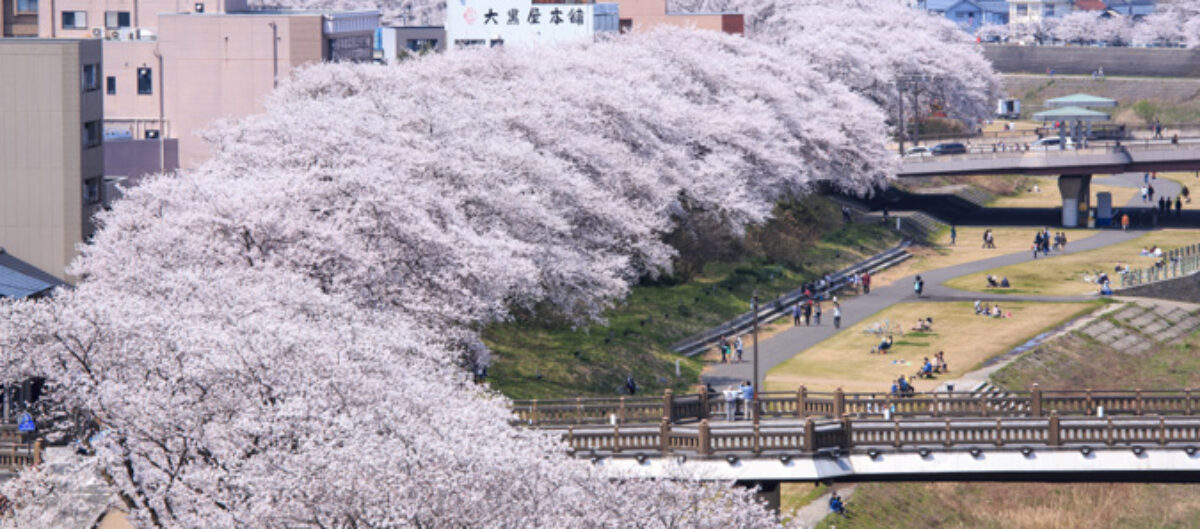

October/3/2020
Located in the central city of Fukui, Tsukumo Bridge spans the Asuwa River. I wrote about the Asuwa River once before.(The Asuwa River: a river that runs through the central part of Fukui)





In my opinion, there are four interesting points about Tsukumo Bridge(九十九橋 in Japanese).
- It has a more than 400-year history.
- Half of the bridge was made of wood, and the other half was made of stone, so it was well known in Japan.
- Katsushika Hokusai, a world-famous ukiyoe painter, painted it.
- There’s a touching legend about the bridge. (The story of hitobashira(human pillar).)

Tsukumo Bridge was built about 400 years ago by Shibata Katsuie, a military commander who laid the foundations of the city of Fukui. The bridge was a very important entrance to this castle town. The stone used to build the bridge was the Shakudani type, which is a Fukui specialty.
Until 1909, the bridge was half wood and half stone. The present Tsukumo Bridge was built out of reinforced concrete in 1986. It isn’t made of wood anymore.



Why was the bridge half wood and half stone?
There are a few theories.
First, when enemies came, they could burn the part of the bridge made of wood to prevent them from coming into the city.
Second, ships needed to go under the bridge, so it had to be high enough. There were no long stones, so wood was used for the half part that ships went under.
Since the bridge was unique and well known around Japan, a world-famous ukiyoe painter, Katsushika Hokusai (1760-1849), painted it. Ukiyoe is a genre of Japanese art, which flourished from the 17th through 19th centuries.

I found the picture of the bridge that Hokusai painted on the Internet(Fukui Bridge in Echizen Province (Echizen Fukui no hashi), from the series Remarkable Views of Bridges in Various Provinces(Shokoku meikyo kiran)). The bridge was painted in the bottom-left corner of the picture. You can see the wood and stone of the bridge clearly.
There’s a moving legend about the origin of Tsukumo Bridge as follows.
“It’s said that Shibata Katsuie arranged the construction of Tsukumo Bridge, and it spans the Asuwa River with half of it made of wood and the other half made of stone.
During the construction of the bridge, Kansuke, who was the leader of the stonecutters, was responsible for cutting out the 48 stone pillars that supported the bridge. Katsuie was so strict that he told Kansuke if he couldn’t meet the deadline, he’d be sentenced to death.
Kansuke worked night and day with all of his might. However, he’d never worked on such a big project and cutting out stone pillars was more difficult than he’d thought. The work was very hard, but he managed to cut out 47 stone pillars. However, he reached a deadlock at the last one.
The last stone pillar was a little too short for the bridge. He couldn’t add anything to it. The deadline was approaching and he was in a tight spot.
Kansuke had an elderly mother who was sick in bed for a long time. She saw her son’s struggle and said the following to him.
“I have a stone coffin, which you made for me. Why don’t you place me in the stone coffin and put it under the last short stone pillar? Then it’ll be long enough to support the bridge and your work will be complete. I’m old and I won’t live much longer, so I’m willing to be a pillar for the bridge you built and protect it for you until the end.”
Kansuke was touched by her remarks, but he declined. However, he had a responsibility to finish his work, so at last, he had no choice but to accept her offer. He placed the stone coffin, with his mother inside, at the bottom of the river. Then, he placed the last short pillar on top of it. Surprisingly, the height of the last pillar was the same as the other 47 pillars, and he managed to meet the deadline at the last moment. His life was saved.
This story spread among the people and Katsuie was moved when he heard it. He arranged a warm Buddhist memorial service for Kansuke’s mother at a temple.”(Source: 九十九橋ものがたり写真集)
If you know this story, you’ll see the bridge differently.

Tsukumo Bridge has a 400-year history and it’s still an important symbol of Fukui. If you use your imagination, you might see the half-wood, half-stone bridge in your heart like it was 400 years ago.
It’s about a 20-minute walk there from Fukui Station. If you come to Fukui, why don’t you go to Tsukumo Bridge?
(References)
「九十九橋ものがたり写真集」(新九十九橋名橋化促進会)
「福井の名橋 九十九橋」(福井県)
「福井県の歴史散歩」(福井県の歴史散歩編集委員会)(株式会社 山川出版社)
「九十九橋架替の土木史的考察」(加藤哲男、塚本勝典、水野雅男)(第8回日本土木史研究発表会論文集 1988年6月)
「九十九橋の復元的研究」(吉田純一)(福井工業大学研究紀要 第36号 2006)
「福井城下の視的考察(4)九十九橋について」(伊豆蔵庫喜)(福井工業大学研究紀要 第26号 1996)
